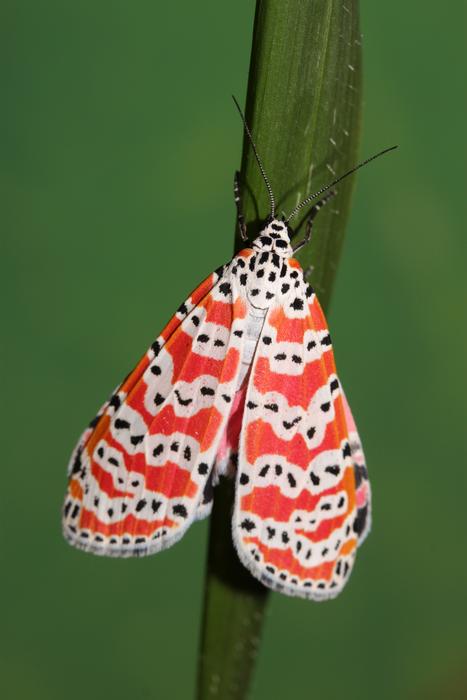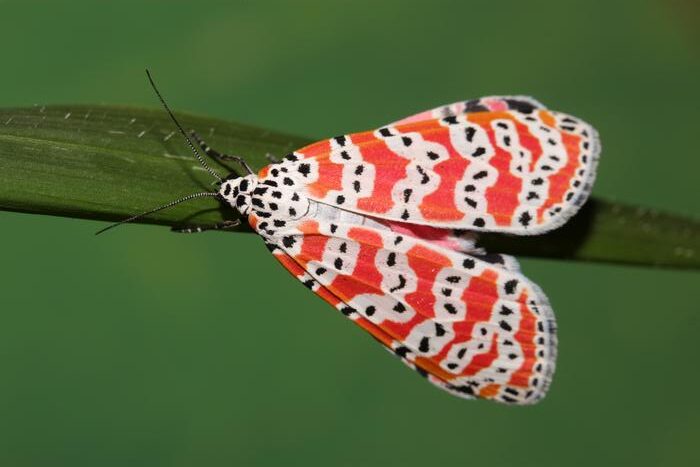Pyrrolizidine alkaloids are as bitter and toxic as they are hard to pronounce. They’re produced by several different types of plants and are among the leading causes of accidental death in cattle.

Credit: Andrei Sourakov
Pyrrolizidine alkaloids are as bitter and toxic as they are hard to pronounce. They’re produced by several different types of plants and are among the leading causes of accidental death in cattle.
Plants that contain these alkaloids have made it very clear they don’t want to be consumed, but that hasn’t deterred bella moths (Utetheisa ornatrix). These day-flying moths exclusively eat the alkaloid-laden leaves and seeds of rattlebox plants. They then use the toxin to guard their eggs and deter predators in later life stages. They even use it to make pheromones that attract mates.
Exactly how bella moths and related species evolved the ability to safely consume pyrrolizidine alkaloids remains unknown.
In a new study published in the journal PNAS, researchers sequence the bella moth genome, which they used to pinpoint specific genes that may confer immunity to these toxins. They also sequenced genomes from 150 museum specimens — some more than a century old — to determine where bella moths and their close relatives originated. Finally, they combed through genetic data looking for clues that could help explain how the intricate wing patterns of bella moths evolved over time — the first study on moths or butterflies that has done so using dry museum collection specimens.
“We’ve managed to show that you can use museum specimens to answer genetic questions that normally require complicated laboratory techniques,” said study co-author Andrei Sourakov, collections coordinator at the Florida Museum of Natural History’s McGuire Center for Lepidoptera and Biodiversity. “This opens a window for future research of this kind.”
Sourakov has been studying bella moths for 15 years and said sequencing the genome for this species was the natural next step in the research he’s conducted so far. Many of the insights he gained during that time came from his work with undergraduate and high school students, whom he helped conduct short experiments, analyze data for science fairs and interpret the results in peer-reviewed papers.
In one such project, a student set out to determine the average lifespan of bella moth adults and inadvertently stumbled across the Methuselah of the moth world. “To our great surprise, they can live for up to 50 days, which is four to five times longer than the average moth,” Sourakov said.
Longevity is not a critically important trait in most moth species. Many breed once, then die shortly after, either from senescence or predation. But bella moths aren’t limited by the latter, making it more likely that genes conferring increased longevity will be beneficial and passed down to the next generation.
“It makes sense for something that’s chemically defended to live longer, because even if they’re caught, the predator most often lets go, and the moth can continue flying around.”
Bella moths live throughout much of eastern North America, Central America and the Caribbean and are often active during the day. Rather than using darkness as a shroud to avoid predators, bella moths make a point of being seen. Their wings are garbed with radiant pink, pearl, onyx and sulfur yellow scales, which birds and carnivorous insects can easily spot from a distance. Any predator unlucky enough to catch a bella moth quickly corrects its mistake.
“Banana spiders will cut them out of their webs,” Sourakov said, adding that wolf spiders and birds will go out of their way to avoid them. “When caught, they produce foaming liquid that tastes bad made almost entirely out of alkaloids.”
When ready to mate, females release a plume of aerosolized alkaloids derived from the plants they ate as caterpillars. Males are attracted to this scent, which they follow to its source. There, they perform a short but elaborate ritual in which they gently touch the female’s head with two fluffy and retractable structures that bear a strong resemblance to dandelions. Each filament in these structures is laced with pyrrolizidine alkaloids.
If the female decides the male has a sufficient quantity and quality of alkaloids stored up, the pair will mate. When finished, the male leaves behind a parting gift called a spermataphore, which contains sperm and, yes, more alkaloids. The female will use this and alkaloids from her own reserve to infuse the resulting eggs with toxins. This sort of biparental egg protection in insects is rare. In fact, when it was first observed in 1989 among bella moth adults, it was the only known example of a male moth or butterfly that invested any chemical resources in its progeny.
Bella moths are able to avoid the ill effects of pyrrolizidine alkaloids by using a special enzyme that oxidizes the molecule, rendering it harmless. If a predator eats a moth, however, the process is reversed, and the alkaloid regains its potency.
Pyrrolizidine alkaloids likely first evolved as a defense mechanism in plants, which then became a commodity for moths. Sourakov and his colleagues wanted to know how bella moths acquired this detoxifying enzyme and how they maintained it through an arms race millions of years long between plant and moth.
The authors discovered bella moths have not one but two copies of the gene that codes for their unique detoxifying enzyme. They may have acquired the second through a process of gene duplication, whereby other species, including many plants, have evolved new traits.
They also found two copies of a gene partially involved in antioxidant production and defense. Sourakov suspects these genes may be related both to the ability of bella moths to detoxify alkaloids and to their remarkable longevity.
“Certain types of stress on biological systems result in a longer lifespan. It could be that the interaction bella moths have with alkaloids is not only the reason why it makes sense for them to live long lives, but also one of the mechanisms behind it.”
Journal
Proceedings of the National Academy of Sciences
DOI
10.1073/pnas.2319726121
Article Title
What one genus of showy moths can say about migration, adaptation, and wing pattern
Article Publication Date
17-Apr-2024




